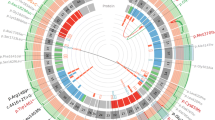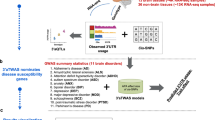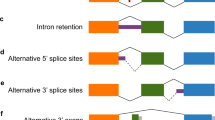Abstract
Fragile X-associated tremor/ataxia syndrome (FXTAS) is a neurodegenerative disorder caused by an expansion of 55–200 CGG repeats (premutation) in the 5'-UTR of the FMR1 gene. Bidirectional transcription at FMR1 locus has been demonstrated and specific alternative splicing of the Antisense FMR1 (ASFMR1) gene has been proposed to have a contributing role in the pathogenesis of FXTAS. The structure of ASFMR1 gene is still uncharacterized and it is currently unknown how many isoforms of the gene are expressed and at what level in premutation carriers (PM) and if they may contribute to the premutation pathology. In this study, we characterized the ASFMR1 gene structure and the transcriptional landscape by using PacBio SMRT sequencing with target enrichment (IDT customized probe panel). We identified 45 ASFMR1 isoforms ranging in sizes from 523 bp to 6 Kb, spanning approximately 59 kb of genomic DNA. Multiplexing and sequencing of six human brain samples from PM samples and normal control (HC) were carried out on the PacBio Sequel platform. We validated the presence of these isoforms by qRT-PCR and Sanger sequencing and characterized the acceptor and donor splicing site consensus sequences. Consistent with previous studies conducted in other tissue types, we found a high expression of ASFMR1 isoform Iso131bp in brain samples of PM as compared to HC, while no differences in expression levels were observed for the newly identified isoforms IsoAS1 and IsoAS2. We investigated the role of the splicing regulatory protein Sam68 which we did not observe in the alternative splicing of the ASFMR1 gene. Our study provides a useful insight into the structure of ASFMR1 gene and transcriptional landscape along with the expression pattern of various newly identified novel isoforms and on their potential role in premutation pathology.






Similar content being viewed by others
Data Availability
The datasets generated during and/or analyzed during the current study are available from the corresponding author on reasonable request.
References
Hagerman RJ, Leehey M, Heinrichs W et al (2001) Intention tremor, parkinsonism, and generalized brain atrophy in male carriers of fragile X. Neurology 57:127–130
Mila M, Alvarez-Mora MI, Madrigal I, Rodriguez-Revenga L (2018) Fragile X syndrome: an overview and update of the FMR1 gene. Clin Genet 93:197–205
Sellier C, Rau F, Liu Y et al (2010) Sam68 sequestration and partial loss of function are associated with splicing alterations in FXTAS patients. EMBO J 29:1248–1261
Tassone F, Hagerman RJ, Taylor AK et al (2000) Elevated levels of FMR1 mRNA in carrier males: a new mechanism of involvement in the Fragile-X syndrome. Am J Human Genet 66:6–15
Hagerman RJ, Hagerman P (2016) Fragile X-associated tremor/ataxia syndrome - features, mechanisms and management. Nat Rev Neurol 12:403–412
Su C-H, Dhananjaya D, Tarn W-Y (2018) Alternative splicing in neurogenesis and brain development. Front Mol Biosci 5:12
Paronetto MP, Passacantilli I, Sette C (2016) Alternative splicing and cell survival: from tissue homeostasis to disease. Cell Death Differ 23:1919–1929
Quesnel-Vallières M, Dargaei Z, Irimia M et al (2016) Misregulation of an activity-dependent splicing network as a common mechanism underlying autism spectrum disorders. Mol Cell 64:1023–1034
Koch L (2018) Altered splicing in Alzheimer transcriptomes. Nat Rev Genet 19:738–739
Pretto DI, Eid JS, Yrigollen CM et al (2015) Differential increases of specific FMR1 mRNA isoforms in premutation carriers. J Med Genet 52:42–52
Tseng E, Tang H-T, AlOlaby RR et al (2017) Altered expression of the FMR1 splicing variants landscape in premutation carriers. Biochim Biophys Acta Gene Regul Mech 1860:1117–1126
Zafarullah M, Tang H-T, Durbin-Johnson B et al (2020) FMR1 locus isoforms: potential biomarker candidates in fragile X-associated tremor/ataxia syndrome (FXTAS). Sci Rep 10:11099
Khalil AM, Faghihi MA, Modarresi F et al (2008) A novel RNA transcript with antiapoptotic function is silenced in fragile X syndrome. PLoS One 3:e1486
Pastori C, Peschansky VJ, Barbouth D et al (2014) Comprehensive analysis of the transcriptional landscape of the human FMR1 gene reveals two new long noncoding RNAs differentially expressed in Fragile X syndrome and Fragile X-associated tremor/ataxia syndrome. Hum Genet 133:59–67
Ladd PD, Smith LE, Rabaia NA et al (2007) An antisense transcript spanning the CGG repeat region of FMR1 is upregulated in premutation carriers but silenced in full mutation individuals. Hum Mol Genet 16:3174–3187
Al Olaby RR, Tang H-T, Durbin-Johnson B et al (2018) Assessment of molecular measures in non-FXTAS male premutation carriers. Front Genet 9:302
Vittal P, Pandya S, Sharp K et al (2018) splice variant: a predictor of fragile X-associated tremor/ataxia syndrome. Neurol Genet 4:e246
Loesch DZ, Godler DE, Evans A et al (2011) Evidence for the toxicity of bidirectional transcripts and mitochondrial dysfunction in blood associated with small CGG expansions in the FMR1 gene in patients with parkinsonism. Genet Med 13:392–399
Tseng E, Rowell WJ, Glenn O-C et al (2019) The landscape of SNCA transcripts across synucleinopathies: new insights from long reads sequencing analysis. Front Genet 10:584
Sheynkman GM, Tuttle KS, Laval F et al (2020) ORF Capture-Seq as a versatile method for targeted identification of full-length isoforms. Nat Commun 11:2326
Pretto DI, Mendoza-Morales G, Lo J et al (2014) CGG allele size somatic mosaicism and methylation in FMR1 premutation alleles. J Med Genet 51:309–318
Tassone F, Pan R, Amiri K et al (2008) A rapid polymerase chain reaction-based screening method for identification of all expanded alleles of the fragile X (FMR1) gene in newborn and high-risk populations. J Mol Diagn 10:43–49
Filipovic-Sadic S, Sah S, Chen L et al (2010) A novel FMR1 PCR method for the routine detection of low abundance expanded alleles and full mutations in fragile X syndrome. Clin Chem 56:399–408
Edgar RC (2004) MUSCLE: multiple sequence alignment with high accuracy and high throughput. Nucleic Acids Res 32:1792–1797
Tassone F, Hagerman RJ, Chamberlain WD, Hagerman PJ (2000) Transcription of the FMR1 gene in individuals with fragile X syndrome. Am J Med Genet 97:195–203
Castro AF, Loureiro JR, Bessa J, Silveira I (2020) Antisense transcription across nucleotide repeat expansions in neurodegenerative and neuromuscular diseases: progress and mysteries. Genes 11:1418. https://doi.org/10.3390/genes11121418
Verkerk AJ, Pieretti M, Sutcliffe JS et al (1991) Identification of a gene (FMR-1) containing a CGG repeat coincident with a breakpoint cluster region exhibiting length variation in fragile X syndrome. Cell 65:905–914
Hinds HL, Ashley CT, Sutcliffe JS et al (1993) Tissue specific expression of FMR-1 provides evidence for a functional role in fragile X syndrome. Nat Genet 3:36–43
Sánchez-Jiménez F, Sánchez-Margalet V (2013) Role of Sam68 in post-transcriptional gene regulation. Int J Mol Sci 14:23402–23419
Frisone P, Pradella D, Di Matteo A et al (2015) SAM68: signal transduction and RNA metabolism in human cancer. Biomed Res Int 2015:528954
Acknowledgements
We thank the participants of the community‐based studies who donated their time and sample for this study. This paper is dedicated to the memory of Matteo.
Funding
This work was supported by the NIH grants RO1HD036071 and RO1MH07804.
Author information
Authors and Affiliations
Contributions
Designed Research.
Conception: F. Tassone
Organization: M. Zafarullah, and F. Tassone
Execution: M. Zafarullah, F. Tassone
Analyzed Data
Design: F. Tassone, E. Tseng
Execution: J.LI, E. Tseng,
Review and Critique: M. Zafarullah, J. Li, E. Tseng, F. Tassone
Manuscript Preparation
Writing the first draft: M. Zafarullah
Review and Critique: M. Zafarullah, J. Li, E. Tseng, F. Tassone
All authors read and approved the final manuscript.
Corresponding author
Ethics declarations
Ethics Approval
All samples were collected under approved Institutional Review Board (IRB) protocols and all methods were carried out in accordance with the relevant guidelines and regulations.
Consent to Participate
Informed consent was obtained from all individual participants included in the study.
Consent for Publication
Not applicable.
Competing Interests
M.Z.: No disclosures to report.
J.L.: No disclosures to report.
E.T: E.T. is an employee of Pacific Biosciences.
F.T. has received the funding from Azrieli Foundation and Zynerba for studies in Fragile X syndrome.
Additional information
Publisher's Note
Springer Nature remains neutral with regard to jurisdictional claims in published maps and institutional affiliations.
Supplementary Information
Below is the link to the electronic supplementary material.
Rights and permissions
Springer Nature or its licensor (e.g. a society or other partner) holds exclusive rights to this article under a publishing agreement with the author(s) or other rightsholder(s); author self-archiving of the accepted manuscript version of this article is solely governed by the terms of such publishing agreement and applicable law.
About this article
Cite this article
Zafarullah, M., Li, J., Tseng, E. et al. Structure and Alternative Splicing of the Antisense FMR1 (ASFMR1) Gene. Mol Neurobiol 60, 2051–2061 (2023). https://doi.org/10.1007/s12035-022-03176-9
Received:
Accepted:
Published:
Issue Date:
DOI: https://doi.org/10.1007/s12035-022-03176-9




